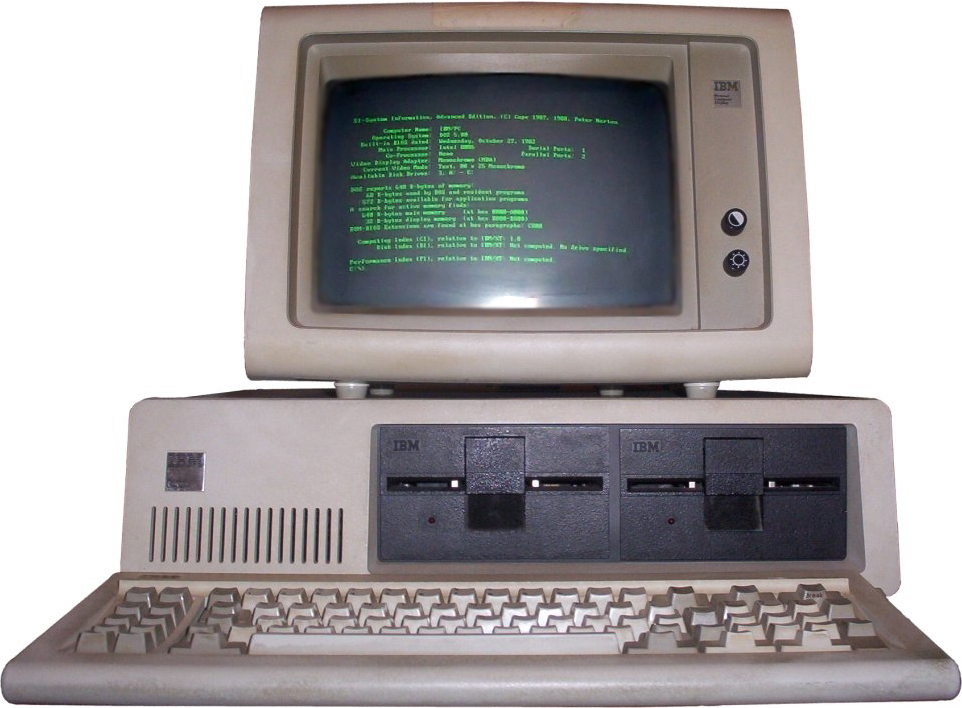 The IBM 5150, the pinnacle of Moore’s law. The IBM 5150 is one of the first computers that really brought the keyboard and processor to the home. It revolutionized the market and help set the standards that other computer of the past and even now follow. It is hard to believe that a decade before computers were the size of a bedroom room, needing to be cooled with an air conditioner and run by a group of 20 men to being able to sit on top of a desk with double the processing power.
The IBM 5150, the pinnacle of Moore’s law. The IBM 5150 is one of the first computers that really brought the keyboard and processor to the home. It revolutionized the market and help set the standards that other computer of the past and even now follow. It is hard to believe that a decade before computers were the size of a bedroom room, needing to be cooled with an air conditioner and run by a group of 20 men to being able to sit on top of a desk with double the processing power. The IBM 5150 was released on August 12, 1981 with relatively positive views. It was the first for the major computer company because they mostly dominated the office space, but began to be interested in the home market as IBM saw the growth of consumer pc. There was 40,000 IBM 5150 pc order on the day of the announcement and the numbers grew. This was a major blow towards IBM new competitors Apple and Atari and other smaller companies as IBM would also take over the new personal market as well as the office market too.
The IBM 5150 was released on August 12, 1981 with relatively positive views. It was the first for the major computer company because they mostly dominated the office space, but began to be interested in the home market as IBM saw the growth of consumer pc. There was 40,000 IBM 5150 pc order on the day of the announcement and the numbers grew. This was a major blow towards IBM new competitors Apple and Atari and other smaller companies as IBM would also take over the new personal market as well as the office market too.
This segment I would mostly use to talk about how things work, but since it is a basic computer ( you know a processor, ram, etc) I feel that it is not as interesting to talk about. What I am going to talk about is how IBM was able to have the success they did with the 5150 and how they set standards for future computers to come. The 5150 was developed in 12 months which was the quickest development time in IBM’s history and the contributing factor of this is the off the shelf parts IBM used from it’s other computers. This made upgrades simple and easy and kept prices low. This help lead to a new set of computers, parts, and accessories called “IBM Compatible” These “compatibles” help standardize things such as the joystick port, floppy disk, printer port, Bios, and even the keyboard like mechanical keyboard, which have “satisfying” click to them.
Many computer enthusiast consider the 5150 as one of the best computers ever built. Not because of its specification especially now since a microwave probably has more processing power than it but because of how revolutionary it was. No other computer had such an impact on the personal computer market like it. It was a truly a well developed computer that became a role model for so many others to follow.
FUN FACT: IBM used Charlie Chaplin's Little Tramp character in a series of advertisements to promote their home computers
source:https://en.wikipedia.org/wiki/IBM_Personal_Computer#Reception

Wow! The idea of taking a massive piece of machinery and compacting it into three small parts that could easily fit in a home office in such a short amount of time is very mind blowing and quite interesting. Now we can find these things in our pockets. Awesome blog.
ReplyDelete